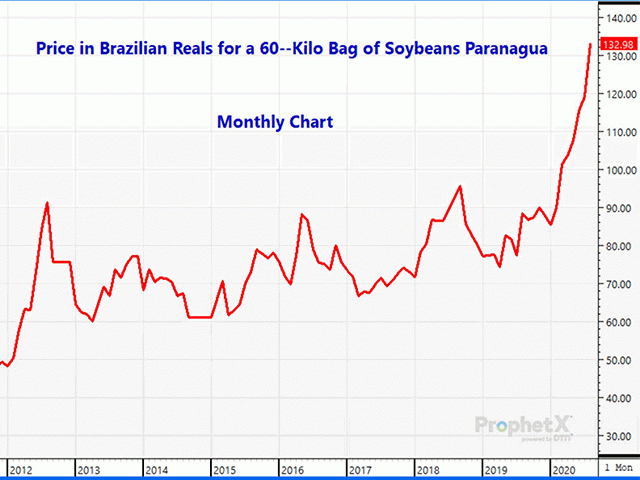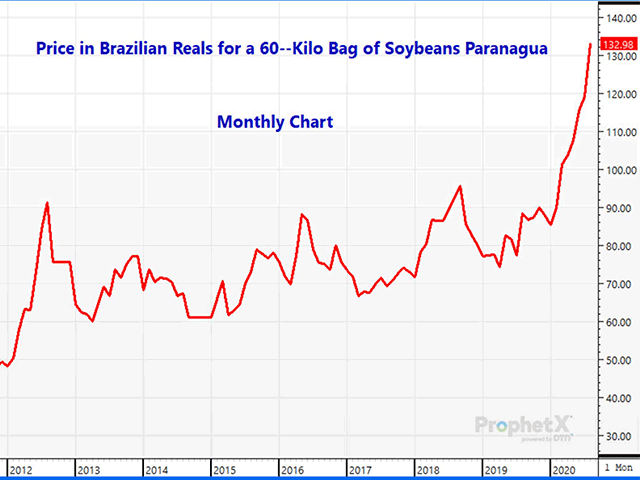South America Calling
Tight Supply, Falling Currency Fuels Planting Incentive
As we approach September, it marks the start of the new soybean planting effort from South American farmers. This year's start is expected to begin in the middle of September in Brazil. The forecast for central and northern Brazil appears to be dry for the next two weeks, according to DTN Senior Ag Meteorologist Bryce Anderson, with temperatures mostly above normal. It is possible that we could see the start of Brazilian planting delayed for a week or more, as farmers await more rain. Planting typically begins in mid-September and finishes up in December. Argentine planting typically begins in October and finishes up in December. We will focus on Brazil for the purposes of this blog.
One thing is for sure heading into the planting season in 2020: In Brazil, the farmer is looking at an all-time-high price for soybeans with its currency in reals hitting 133.80 in August, while in corn, that price also just reached a historical high on Wednesday (60.41 reals). In one year, the Brazilian reals fell roughly 33% to the U.S. dollar. Brazilian soybean prices in U.S. dollars are also very high.
P[L1] D[0x0] M[300x250] OOP[F] ADUNIT[] T[]
Despite the fact that old-crop soybean supplies are exhausted after a surge in sales to China in 2019-20, the price of soybeans in the Brazilian currency is at a historical high (see the monthly chart below). The Brazilian real has fallen close to the historical low (0.1685) versus the U.S. dollar, currently at 0.1781. The historical low, which was established in mid-May of 2020, gave Brazilian farmers every reason to plant soybeans fencerow to fencerow. That sentiment is being shared by USDA, in its August World Agricultural Supply and Demand Estimates (WASDE) report, but also confirmed by the Brazilian Supply Company, CONAB, on Aug. 25. CONAB is virtually the Brazilian counterpart to our own USDA.
The estimate for soybean planting is for a 3% to 4% boost in planted acres. WASDE, in August, estimated Brazilian soybean production to be a record large 131 million metric tons (4.8 billion bushels). CONAB sees a 3% boost in planted acreage, but it projects an even larger 133.5 mmt (4.9 bb) crop. That would be an increase of 7.5 mmt (276 mb) over 2019-20 production, and 14.5 mmt (533 mb) higher than the 2018-19 production. Fueling the anticipated increase in acreage is good profitability, potential increased buying by China, and estimates that biodiesel usage is expected to move 12% to 13% higher by March of 2021. The August USDA/WASDE report raised China crush by 3 mmt, to 98 mmt, and raised China's soybean imports by 3 mmt, to 99 mmt (3.6 bb).
It is virtually the same scenario in corn as in soybeans. With prices to the farmer in reals, up nearly 10% for the month of August, and establishing a new record high, and strong export demand, planted acres are projected to be 7% higher by CONAB. That is expected to lead to a new record-large crop of 112.9 mmt (4.44 bb). This crop would far exceed the recent record-large crop of 102.14 mmt for 2019-20 and is well above the WASDE August projection of 107 mmt. A crop of 112.9 mmt would be nearly 11 mmt higher than a year ago, which was also a record-large crop. Due to the fall in the real currency relative to the U.S. dollar, corn prices in Mato Grosso were 29% higher than a year ago.
So, while the U.S. is enjoying the current price advantage to Brazil on an FOB basis, leading to a surge in export demand from China for both commodities, that euphoria could very well be short-lived. The renewed weakness in Brazil's real currency has rendered Brazil offers uncompetitive, while giving the U.S. new-found demand. It has, at the same time, gave Brazilian farmers incentive to plant additional acres. If weather cooperates, and the above-acreage assumptions are correct, Brazil should once again provide serious competition to the U.S. in the late-winter/early spring. On top of what could be near-record U.S. corn and soybean crops harvested in a few months, the idea that Brazil could have a combined 19 mmt (698 mb) more of new-crop corn and soybeans combined, assuming good weather, does not bode well for higher prices down the road. U.S. farmers should take advantage of the current price discrepancy. Of course, all of this depends on weather. These pre-planting estimates are simply a starting point, and, as 2019 taught us, there is plenty of weather uncertainty ahead.
Dana Mantini can be reached at dana.mantini@dtn.com
Follow Dana on Twitter @mantini_r
© (c) Copyright 2020 DTN, LLC. All rights reserved.





Comments
To comment, please Log In or Join our Community .